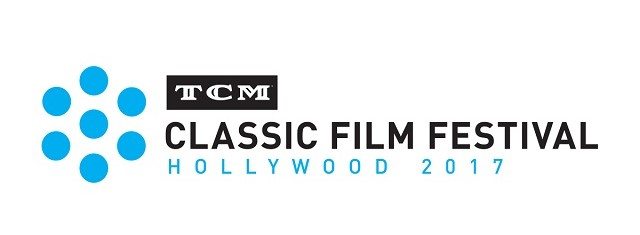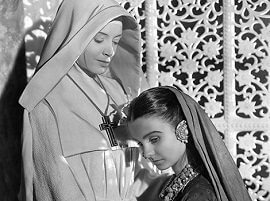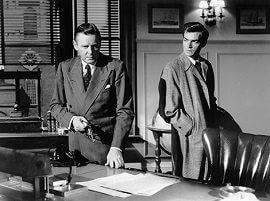The TCM Classic Film Festival just concluded its 8th glorious year in Hollywood. This year’s theme was Make ‘Em Laugh but the festival did not limit itself to just comedies. There was a sidebar of films featuring comic actors in serious roles as well as a collection of films projected on nitrate (you know, that combustible, highly unstable film stock that bursts into flames in Cinema Paradiso and Inglourious Basterds). The appeal of the TCM Classic Film Festival is that there is great care taken with the presentation of the films and the screening experience. The TCM network takes pride in showcasing classic films and its festival wants to show those films under the best possible conditions, sometimes striking new 35mm film prints just for the festival.
This year the TCM Classic Film Festival partnered with Martin Scorsese’s The Film Foundation, Hollywood Foreign Press Association, The Academy Archive, and American Cinematheque to bring The Egyptian Theater’s projection booth up to fire code specs so that it could show original nitrate prints of a quartet of films. Kodak retired nitrate film stock back in 1952 (because of its unstable nature and difficulty of safely storing prints and negatives) but nitrate prints still exist in archives and are renowned for their incandescent beauty.
I attended about a quarter of the 80 films screened at this year’s festival and here are my top 10 film experiences.
1. Black Narcissus (1947)
Martin Scorsese, a passionate supporter of film preservation through his non-profit The Film Foundation, introduced the first nitrate film screening at the TCM Classic Film Festival. It was Alfred Hitchcock’s 1934 film The Man Who Knew Too Much. Scorsese praised the beauty and luminosity of nitrate prints then matter-of-factly added they can “blow up.” TCMFF screened the Hitchcock film, the film noir Laura, the musical Lady in the Dark, and the Michael Powell-Emeric Pressburger film Black Narcissus. Of the four Black Narcissus was the true standout.
Filmed in breathtakingly bold Technicolor by Jack Cardiff, the nitrate print presented blacks that were rich and deep, and the light hitting the young prince’s jewels positively shimmered off the screen. The film focuses on a small group of nuns in a small convent in the Himalayas. Deborah Kerr leads the sisters but it is Kathleen Byron as Sister Ruth who steals the picture. Byron’s portrait of a descent into insanity is absolutely riveting.
2. So This is Paris (1926)
This silent comedy came in number two because it not only provided an early glimpse of the witty skill of Ernst Lubitsch but it was presented with live piano accompaniment. This is how people used to view silent films and it was a delight. Lubitsch is in top form despite the film being one of his early endeavors. His humor is smashingly apparent in the opening shots depicting a married couple rehearsing a passionate scene from some sultry Arabian romance. Their lovemaking is interrupted by the missus having an awkward itch she needs to scratch. The film also features a wildly kinetic Charleston competition.
The festival highlighted another Lubitsch film, his 1932 pre-code comedy One Hour With You that featured a charming Maurice Chevalier as a blissfully happy married man tempted by his wife’s best friend to fool around. Both films reveal the famous Lubitsch touch that is light, deft, and delivers the unexpected at every turn.
3. The Great Dictator (1940)
The final film to feature Charlie Chaplin’s The Little Tramp is a political satire that proves stunningly resonant today. The film concerns a Jewish barber who ends up trading places with a Hitler-like dictator named Adenoid Hynkel. The screening was preceded by a Three Stooges short, You Natzy Spy! (also from 1940). In his introduction to the films, Indiana University Professor Michael Uslan noted that it was these comedies that were the first to directly tackle the threat of Hitler and they did so – as Mel Brooks would do decades later – through ridicule. Uslan also noted that Hitler had The Great Dictator screened for him twice but he did not state any opinion of the film publicly or privately.
The film marked Chaplin’s first true sound picture but the most memorable scene might be one without any words, the scene where dictator Adenoid Hynkel does a ballet with a floating globe to convey his dreams of global domination. The film is hilarious, poignant, angry, and scary in assessing the threat Hitler posed. Chaplin’s final speech about tyrants and greed, and our need to fight both prove deeply moving. Here’s a sample of his final words in the film where the baker impersonating Hynkel must make a speech to a huge crowd at a rally:
“I don’t want to rule or conquer anyone. I should like to help everyone—if possible—Jew, gentile—black man—white. We all want to help one another. Human beings are like that. We want to live by each other’s happiness—not by each other’s misery. We don’t want to hate and despise one another. In this world there is room for everyone… Greed has poisoned men’s souls, has barricaded the world with hate, has goose-stepped us into misery and bloodshed… We think too much and feel too little. More than machinery we need humanity. More than cleverness we need kindness and gentleness. Without these qualities, life will be violent and all will be lost…”
The Great Dictator proved to be Chaplin’s biggest financial success and the TCM Classic Film Festival screening proves how timeless and perfectly crafted a film it is.
4. Cock of the Air (1931)
In this Howard Hughes produced comedy, Chester Morris is a womanizing pilot and Billie Dove is a Parisian songstress who sets her sights on him. The two engage in a sexy cat-and-mouse-game that involves Dove teasing Morris all the way from Italy to France. Hughes repurposed some of the aerial footage from his Hell’s Angels movie here and had to cut 12 minutes from the film in a bartering game with the Hays Office to get another of his films, Scarface, released. But for this screening, the TCM Classic Film Festival turned to a recently restored print from The Academy Film Archive that returns the film to its original running time.
Morris proves a charming and dashing romantic lead and Dove is radiant and enchanting. Both reveal a lot of skin, she in gowns with revealing décolletage and he in a skimpy towel before showering. There’s also a funny bit involving Joan of Arc, a suit of armor and a can opener. The TCM Classic Film Festival affords rare screenings of early films such as this.
5. Panique (1946)
Another restored print – this one getting a West Coast premiere – makes my top ten list for this year’s festival: Julien Duvivier’s adaptation of George Simenon’s novel, Les Fiançailles de M. Hire. Duvivier had been working in Hollywood but returned to France to make Panique, an unnerving thriller about mob violence. Monsieur Hire (Michel Simon) is a social misfit who gets taken in by a beautiful woman (Viviane Romance) who has just been released from prison after serving time to cover for her murderous lover (Paul Bernard).
The film is a glorious example of French film noir. It was preceded by a discussion with Pierre Simenon, the son of Belgian novelist Georges Simenon. Pierre revealed his father’s disdain for cinema even though he maintained friendships with great filmmakers such as Federico Fellini and Jean Renoir. Only one person in the audience claimed to have seen any version of the film. That made the screening pretty remarkable.
6. Beat the Devil (1953)
When first released, Beat the Devil bombed at the box office and baffled many critics. It was a hilarious comedy but with people – Humphrey Bogart, Peter Lorre, Jennifer Jones – not best known for making funny films and the source material was a serious novel by Claud Cockburn. At the TCM Classic Film Festival screening Angela Allen, script supervisor for John Huston on Beat the Devil, recalled glorious stories about the film’s chaotic production. She said they had to shoot in sequence because Truman Capote was writing the script as they went along and no one knew where the film was going. The TCM Classic Film Festival program notes state very accurately: “Jennifer Jones’ surname in this film provides a key to its tone: in Yiddish folklore, ‘Chelm’ is the name of a village ruled by fools. On-screen and off, this takeoff on international caper films seemed to be a tale told by idiots.”
Three of the chief idiots are played by Peter Lorre, Robert Morley, and Marco Tulli. The festival provided the fun opportunity to see Lorre in his first English language film (The Man Who Knew Too Much) as well as one of his last (Beat the Devil) and to see that he lost none of his spark. The film showcases Huston’s gift for rich supporting characters that are memorable even if they only have one line. A bastardized version of this film with a Bogart voice-over existed for a while but seek this original cut of the film out for a fabulous time.
7. Red River (1948)
This Howard Hawks Western pitted John Wayne against Montgomery Clift for a generational tale of Texas cattlemen. Clift is unbearably gorgeous in his second film appearance. The casting is perfect because off screen and as actors Wayne and Clift were opposites and that bled into the on screen performances. After the film, director John Ford, who had worked many times with Wayne, told Hawks, “I didn’t know the son of a bitch could act.” But in this film Wayne stretches his range and even ages to play a cattleman who leads the first cattle drive on the Chisholm Trail.
The cast also boasts Walter Brennan, Joanne Dru (who doesn’t flinch even when shot in the shoulder by an arrow), and John Ireland as the wonderfully named Cherry Valance. There’s a scene with Ireland and Clift comparing their firearms that seems to carry some homoerotic overtones, but you can watch and judge for yourself. This is a classic Western and also impressive for the non-CGI cattle footage.
8. Lured (1947)
This was part of the comedy sidebar called Hey That’s Not Funny where actors known for comedy take on serious roles. In this instance, Lucille Ball (of TV’s I Love Lucy fame) stars in a film noir tale about a serial killer targeting women through personal ads. The role might be serious but you can’t hide Ball’s comedic skills and she puts real zing into her line deliveries that hone in on the humor. At one point she’s a little slow to realize something and notes, “My IQ must have been flying at half mast.” You also get George Sanders confessing to being an “unmitigated cad” and Boris Karloff making a brief appearance as one of the suspects in the case. His scenes are priceless!
This is directed by Douglas Sirk who is best known for his melodramatic women’s pictures. This is a change of pace for him in terms of the material boasting humor and thrills but Sirk’s flair for striking visuals is clearly on display.
9. The Underworld Story (1950)
The TCM Classic Film Festival worked with the Noir Foundation Collection at UCLA to strike a new print of this B film noir. This kind of meticulous care is what makes seeing films at the TCM Classic Film Festival so transcendent and rare. The Underworld Story is not the best noir you’ll ever see but its portrait of a reporter with dubious moral values was a harbinger of Billy Wilder’s better known Ace in the Hole.
The film is controversial now for having cast a white actress, Mary Anderson, in the role of a black woman accused of murder. But the politics of the film – in which white characters come out in defense of a black woman – are quite liberal for 1950. So liberal in fact that they drew the attention of the House Un-American Activities Committee and prompted director Cy Endfield to flee to England when called to testify. Actor Howard DaSilva and screenwriter Henry Blankfort were also called to testify and when they refused to name names they were blacklisted.
10. Kentucky Fried Movie (1977)
This is a ridiculously silly movie but when you have Edgar Wright introducing it with John Landis, Jim Abrahams, David Zucker and Jerry Zucker doing a Q&A before, the whole experience is elevated. This was Landis’ second feature directing gig and the Zuckers and Abrahams would go on to do Airplane!, Top Secret, and TV’s Police Squad. The four men were wildly entertaining as they recounted their early exploits and sometimes not agreeing on exactly how things went down. Abrahams noted that they used to do a comedy show called The Nose just so they could see the title listed in events as “The Nose runs continuously…” That provides insight into how their minds work. The screening was at midnight, and provided the perfect end to a day of classy cinema. Edgar Wright’s obvious joy at being able to talk with these comic legends made the panel all the more fun. It’s like a live version of a bonus feature on a Blu-ray.
Bonus: Beyond the Mouse: The 1930s Cartoons of Ub Iwerks
This was not a film but a collection of shorts by Ub Werks. Werks was known as “the hand behind the mouse” at Disney studios in the early days. These shorts were amazing in their artistry and humor.









